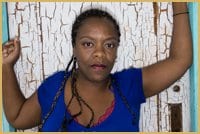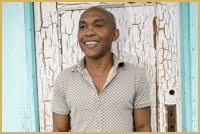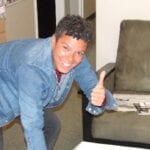
IT'S NOT JUST A HETERO THING: Kona, remembers the battle royale over race on superdyke.com. 'I'm not guilty of that,' many white queers protested. 'That's them. That's hetero whites.' Credit: Sara Race
Deverell Comrie says he’s “okay” identifying as black. There are role models, stories, figureheads he can rattle off to support his sense of self and how he moves around in the world.
He’s also “okay” with being gay. Again, he can lay claim to histories, role models, figureheads.
Being black and gay is a different story.
He draws a blank when trying to pinpoint stories or people that reflect both his blackness and queerness.
“When I think about being a double minority, it gives me an uneasy feeling of what I like to call tiptoe caution. Because on one hand, especially being from Jamaica, being gay is a matter of life and death.
“Then moving here, where you get the chance to express all of being gay, you find that you can’t anyway, not because it’s a matter of life and death, but a matter of how you are made to feel in some kind of silent way. When I’m both, I’m invisible.”
Kenya-born Fatima Jaffer, who identifies as South Asian, says in moving to Canada, she was under the impression that only white people could be queer and only felt comfortable calling herself a lesbian when she met another queer woman of colour.
“Just the invisibility of queer people of colour made me think this was a white phenomenon, and that there was something different about me that wasn’t true to my race in a sense.”
Kona remembers growing up in Edmonton where the only other black person she knew in school until grade 11 was her brother. There were other black people at home and in the church she attended as a child. But as she began exploring and understanding her sexuality, there was “no one who looked like me,” she says pointedly.
“I remember when I was a teenager having this white man come up to me in a party and say, ‘Hey baby, do you suck white cock?’ That was one of the first moments when I realized that what I was, was a fetish.
“I felt I was walking around in the world on my talents, skills and ability. The rest of the world? They were seeing me as a black person first.”
When Kona moved to Vancouver and began immersing herself in the dyke and kink communities, she saw more variety in the bodies she encountered.
But she still didn’t see herself. In fact, she says, her “naked, sexualized, eroticized skin has never been up against the skin of another person of colour.”
The closest she has come to that is an approximation of sorts. That is, white trans men who adopt the language and postures of urban black culture.
“They open their mouth and what comes out seems to be black, but it’s in a white body. I respect they get to do what they want to do, and move through the world however they need to. And I would support and fight for their right to do that,” Kona asserts.
“But as somebody who has never come up against brown skin, if I close my eyes, it’s as if I’m with someone who I could pretend is black, but they’re not.”
The experience, she says, is “quite strange.”
Her actual blackness, she says, is not as celebrated in the broader world, queer or straight.
“I know that my thick lips, my wide nose, my kinky hair, the proportions of my body which are about my genetics, my ancestry —they’re not appreciated. I’m not prized.
“I tend [to be] hesitant around people who I’m engaging with intimately for the first time because I’m afraid they won’t be able to see me in terms of a person with talents, skills and abilities. They’ll be looking at my brown body and at my brown flesh. And it will be brown, before it is flesh. That has happened to me again and again and again.”
A “funny thing” also happened to Nelson Wong as he stepped out of the closet. He found it difficult to be a person of colour.
It was a given he was Asian as he negotiated a straight world of relationship and sexual opportunities. But once he swung open the closet door, the tune on the opportunity jukebox changed dramatically.
All of a sudden, people were saying “they’re not into Asians.”
“If coming out of the closet was supposed to be this promised land of fulfillment, it was incredibly disappointing.”
As for the atmosphere in the online hookup and dating world, Wong says it can be “harsh.”
“It’s amazing. I still see tags that say no fatties, no trolls, no blacks, no Asians.”
Even Wong himself recalls saying he wasn’t into guys of his own ethnicity.
“When I was in the closet I was attracted to other Asian boys. As soon as I came out of the closet, I don’t know if it was internalized self-hatred or resentment, or some other insecurity. I even stated I wasn’t into Asians.
“I still have to put my finger on it. It could be that I was trying to achieve the status quo, what the media depicts as images of the ideal. It could be a status thing,” he muses, adding that he has “mellowed out now since I’ve embraced my ethnicity more.”
For many, if not most, queer people of colour, filtering, negotiating, raging against the assumptions and stereotypes they face about their bodies, cultures and backgrounds is a part of daily living —whether it’s from straight society or from within a broadly defined queer community, both dominated by white images and conceptions of what it means to be queer.
Comrie says he and another queer friend trade opinions constantly about the “white concept” of black gay males. That is, they either fall under the category of “big, burly, strong or queeny, flashy.” Anything in between seems to be an aberration, he contends, adding that white queer men-specifically in Vancouver-do not know how to deal with an intelligent, black male.
“My friend and I always say, ‘Everyone wants to fuck me, no one wants to date me.’
“A lot of people, when they see the skin and they hear the accent, they figure if you talk with an accent, then you must think with an accent. You’re not supposed to be intelligent. You’re supposed to be exotic. That’s how they expect you to act. When you don’t, it seems to push them away.”
Comrie says he’s forever defensive and confrontational around gay white people whenever “any hint of race clichés comes in.”
For her part, Jaffer has observed the almost instant change in social dynamics when she’s been the only person of colour in a predominantly white crowd.
Socializing one-on-one is not a problem, she says. But when she walks into a space like the old Lotus with other persons of colour, it becomes about “us and them.”
“Sometimes, it would be up to 20, 25 of us. I was editor of a lesbian newspaper. I knew everybody and everybody knew me. White lesbians I knew and worked with on a regular basis, when I was in that crowd, they were just cautious and [felt] threatened. You stopped being. You get racialized and you become a person of colour, but in this scary kind of way.”
Jaffer offers a variety of reasons why. One is a fear among whites that they’ll say the wrong thing. The other is the realization among white queers that queer persons of colour have a presence that is quite tangible and powerful.
She remembers the selection process when there were lineups at a women’s club back in the ’90s.
“[They’d] pick and choose people out of the crowd. I remember a woman of colour standing in the lineup in front of me not being picked and white people being picked. And then I would be picked because I ran a newspaper.”
When she voiced her objections, she says, she was met with the usual rebuttal: why do you have to bring race into everything?
Yet when Celebrities opened its doors some three years ago, race and ethnicity quickly became a talking point among those who deemed the staff “too diverse,” says Wong who’s a bartender at the Davie St club.
“They didn’t word it that way, of course. They said Celebrities is too Asian. The mainstream has an overload of white images, but to have one club in a city that has more than 50 percent visible minorities, to have a diverse staff, is something to complain about. It was just a horrible feeling for me to have to confront,” he recalls.
“Luckily, the comments have decreased because Vancouver’s population feels more comfortable in an environment where they feel represented, where they can look across the bar and feel that they have recognition.”
What is disappointing, if not surprising, to queers of colour like Jaffer is the refusal of whites to see, much less acknowledge, the exclusion of queer persons of colour and their perspectives from broader queer community projects.
Projects like Out on Screen’s Queer History Project (QHP) film The Love That Won’t Shut Up that premiered at this year’s film festival.
According to Jaffer, when some audience members questioned the absence of queer persons of colour from the film, one of the responses was: “if you want to see yourselves on screen, why don’t you make a film?”
One person in the film said there were no people of colour in Vancouver in the era the film sought to capture.
A mind-boggling reply, notes Jaffer who says she could have pointed the filmmakers in the direction of several South Asian and black lesbians who would have been going through their own coming out process during the period the QHP film covers. Tapping sources at ImagiNative Aboriginal Media Arts Festival was also an option, she says.
“Why wouldn’t you from the outset maybe have an aboriginal person?” she asks. Why were both filmmakers on the project white, she adds.
From the perspective of many queer people of colour, it is whiteness that pervades the imaging and packaging of the queer community. And it’s a phenomenon that chisels away at self-esteem, body image, identity and the sense of belonging to a greater queer whole.
It’s nothing short of a bombardment, says Comrie.
“I’ve never seen some black gay model all over some gay magazine unless there’s a white guy standing beside him. Why can’t we have two black models embracing?
“So what is being told to us is: you’re not complete unless your partner is white. When have you seen two Chinese guys embracing each other, kissing each other? Go to Manline. When they have interracial couples, it’s a white guy with a black guy, or a Chinese guy with a white guy.”
The feeling that the wider queer community does not get it when queer people of colour say they don’t fit in has led to virtual screaming matches of the internet kind.
Kona remembers the online battle royale on the superdyke forum when drag king Sammy Tomato (aka Sena Hussain) asked a hot-button question about racism in the queer community last December.
“What emerged early on was people of colour going, ‘Hell yeah, there’s racism. Here’s my experience of racism, and here’s how I move through the world, and how I’m hailed or not hailed, and seen or not seen,'” Kona recalls.
“From the white queers, not exclusively, there was a thread of, ‘I’m not guilty of that. That’s not me. I understand you. That’s them. That’s hetero whites. That’s not ours. We’re not doing that. We look at it different. I see you,'” she adds.
A lot of white queers lack the critical lens that will allow them to see, argues Kona, noting the common refrain that Vancouver is multicultural leads many to believe that race isn’t an issue. The belief is this: as long as there’s someone brown on your committee, you’re okay and your work is done.
In work situations, Kona is often aware she’s the voice of colour and those around the table expect her to fulfill that role.
“People look down the table at me, and increasingly where I go is I do not act as the voice of colour. I act as the voice of queerness, because what is visible is my skin. What is not visible is my sexual orientation and the fact that I’m kinky. That is not visible, and so I tend to rotate on that axis.”
It’s the Catch-22 of being of colour and queer in one body. And that holds whether queers of colour are navigating the wider queer community, or negotiating their own ethnic communities which may or may not accept that one of their own is queer.
Comrie, who lost a boyfriend in Jamaica to gaybashing, says he struggles the most when he’s with other black people, especially West Indians.
“I find it easier to be black and gay at work than to be black and gay at Caribana, or black and gay at the Caribbean Festival, or the Ethiopian restaurant down the street.
“Fifteen, 20 years ago when I was just coming out, I had this black woman from the West Indies look at me and say, ‘You can’t be gay. Black people not gay.’ I said, ‘Honey, you probably know so much of them, but you don’t know them.'”
Comrie remembers, half-amused, coming out to one of his brothers as they were chatting on the phone.
His brother’s response? A quick “yeah,” immediately followed by a reminder to call home and follow up on “that thing” Comrie promised to do for him. Later.
It’s a “very English” way of dealing with queerness as opposed to the “oh my god, he’s gay” approach, Comrie explains. It’s more along the lines of “if we pretend it’s not there, then it’s not there.”
Jaffer says she’s out in her Ismaili community and Vancouver’s wider South Asian population, and comes from “a strong position of family.”
She describes her own parents as liberal, and asserts they will “never turn their backs on me.”
If anything, Jaffer was more concerned that her parents would have to deal with community fallout as a result of her sexuality. She herself has faced her own backlash from parts of the South Asian community over the years.
She is front and centre of Trikone, a queer South Asian support group, and has spoken out on issues like same-sex marriage in community media that court a South Asian, and predominantly Punjabi, audience.
“I have a police file of race threats and death threats that I get after I have done that. There are definitely consequences that are very real. I enjoy some protection. I come from a community that supports me, but they kind of have no choice because we’re such a tight community. I do have some kind of privilege.”
Still, Jaffer says it’s not helpful to dwell on the negatives of her community. There are plenty of people willing to do that for her, automatically assuming she’s oppressed because of the community she comes from.
“And I am. Just as everyone else is. But I’m struggling to change my community in the same way the queer community has done for white people in an organized way for the last 30 years,” she says.
“We’ve only just started to realize that we have to build our own organizations like Trikone in order to be able to tackle that kind of work,” she continues.
It’s not helpful when racism in the queer community “invisibilizes and invalidates” queers of colour, she adds.
Take the debate about same-sex marriage. The South Asian community hasn’t even begun to ponder gay marriage and partnerships, Jaffer says, because “we’re still coming out” as individuals.
In fact, a lot of the backlash against marriage came from the broader South Asian community. Rather than ally with us at that time to address the homophobia that was happening, Jaffer says, the marriage debate took place in a very white context.
“What that does is emphasize to our communities of colour it is a white issue.
“I think if people understood that my queer community and their queer community is the same community —and proceed with that and see it as one community —I think it will guide people in the decisions they make about who is visible and who’s being reflected.”
In scanning the landscape of queer politics, leadership, and media images, Wong feels what exists is not enough. If the institutions that represent “gay” continue to just be white, they will lose their usefulness, he warns.
“They’re not going to be the voice of the queer community because the queer community will show itself to be so much more diverse.
I hope that because the queer community now still knows freshly what it feels like to be oppressed and to be on the outside —every single individual, whether they’re white or of colour, understands that feeling —that they can use that understanding so that we can grow in our shared knowledge of each other,” Wong says, “rather than splintering off into little groups that are exclusive or cliques. That’s my hope.”


 Why you can trust Xtra
Why you can trust Xtra


